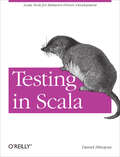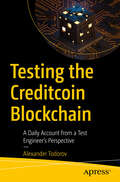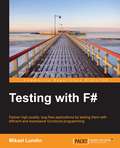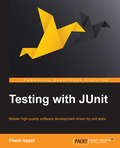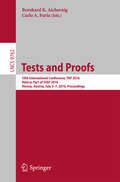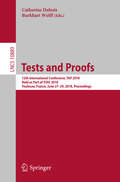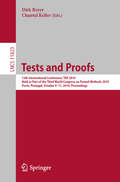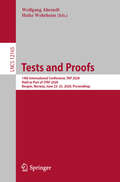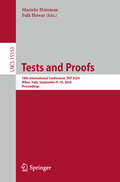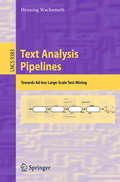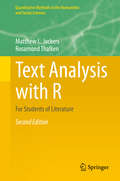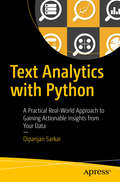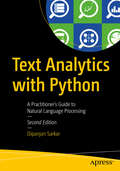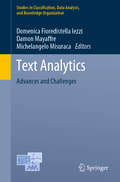- Table View
- List View
Testing in Scala: Scala Tools for Behavior-Driven Development
by Daniel HinojosaIf you build your Scala application through Test-Driven Development, you’ll quickly see the advantages of testing before you write production code. This hands-on book shows you how to create tests with ScalaTest and the Specs2—two of the best testing frameworks available—and how to run your tests in the Simple Build Tool (SBT) designed specifically for Scala projects.By building a sample digital jukebox application, you’ll discover how to isolate your tests from large subsystems and networks with mocking code, and how to use the ScalaCheck library for automated specification-based testing. If you’re familiar with Scala, Ruby, or Python, this book is for you.Get an overview of Test-Driven DevelopmentStart a simple project with SBT and create tests before you write codeDive into SBT’s basic commands, interactive mode, packaging, and historyUse ScalaTest both in the command line and with SBT, and learn how to incorporate JUnit and TestNGWork with the Specs2 framework, including Specification styles, matchers DSLs, and Data TablesUnderstand mocking by using Java frameworks EasyMock and Mockito, and the Scala-only framework ScalaMockAutomate testing by using ScalaCheck to generate fake data
Testing in Scrum
by Tilo LinzThese days, more and more software development projects are being carried out using agile methods like Scrum. Agile software development promises higher software quality, a shorter time to market, and improved focus on customer needs. However, the transition to working within an agile methodology is not easy. Familiar processes and procedures change drastically. Software testing and software quality assurance have a crucial role in ensuring that a software development team, department, or company successfully implements long-term agile development methods and benefits from this framework. This book discusses agile methodology from the perspective of software testing and software quality assurance management. Software development managers, project managers, and quality assurance managers will obtain tips and tricks on how to organize testing and assure quality so that agile projects maintain their impact. Professional certified testers and software quality assurance experts will learn how to work successfully within agile software teams and how best to integrate their expertise. Topics include:Agile methodology and classic process models How to plan an agile project Unit tests and test first approach Integration testing and continuous integration System testing and test nonstop Quality management and quality assurance Also included are five case studies from the manufacturing, online-trade, and software industry as well as test exercises for self-assessment. This book covers the new ISTQB Syllabus for Agile Software Testing and is a relevant resource for all students and trainees worldwide who plan to undertake this ISTQB certification.
Testing the Creditcoin Blockchain: A Daily Account from a Test Engineer's Perspective
by Alexander TodorovFollow the quality engineering journey of the Creditcoin blockchain across four distinct implementation versions and a myriad of technologies. Through the eyes of a test engineer, this book discusses testing implementations with the Hyperledger Sawtooth and Substrate frameworks, testing switch from proof-of-work to proof-of-stake consensus algorithm, and testing an Ethereum Virtual Machine compatibility layer. You’ll traverse several years of fast-paced multiple blockchain implementations and technological changes including an explanation of all major components involved, and the approach taken. You’ll also look at examples of test automation approaches and tools, interesting bugs, and testing challenges. Most everything discussed in Testing the Creditcoin Blockchain is open source, ensuring easy access, and multiple references to source code and GitHub are included throughout. Who This Book Is For Software testers and quality engineers with limited experience working on a blockchain implementation. What You Will Learn Study the many of the components of a distributed blockchain network. See how components work and where testing can be plugged into a distributed blockchain network environment. Glimpse into the daily blockchain testing activities of a principal test engineer. Become familiar with a fast-paced technical software development project.
Testing with F#
by Mikael LundinIf you are a developer who wants to test applications using F#, this is the book for you. Basic experience of testing and intermediate experience of functional programming in F# is expected.
Testing with JUnit
by Frank AppelMaster high quality software development driven by unit tests About This Book * Design and implement robust system components by means of the de facto unit testing standard in Java * Reduce defect rate and maintenance effort, plus simultaneously increase code quality and development pace * Follow a step-by-step tutorial imparting the essential techniques based on real-world scenarios and code walkthroughs Who This Book Is For No matter what your specific background as a Java developer, whether you're simply interested in building up a safety net to reduce regressions of your desktop application or in improving your server-side reliability based on robust and reusable components, unit testing is the way to go. This book provides you with a comprehensive but concise entrance advancing your knowledge step-wise to a professional level. What You Will Learn * Organize your test infrastructure and resources reasonably * Understand and write well structured tests * Decompose your requirements into small and independently testable units * Increase your testing efficiency with on-the-fly generated stand-in components and deal with the particularities of exceptional flow * Employ runners to adjust to specific test demands * Use rules to increase testing safety and reduce boilerplate * Use third party supplements to improve the expressiveness of your verification statements In Detail JUnit has matured to become the most important tool when it comes to automated developer tests in Java. Supported by all IDEs and build systems, it empowers programmers to deliver software features reliably and efficiently. However, writing good unit tests is a skill that needs to be learned; otherwise it's all too easy to end up in gridlocked development due to messed up production and testing code. Acquiring the best practices for unit testing will help you to prevent such problems and lead your projects to success with respect to quality and costs. This book explains JUnit concepts and best practices applied to the test first approach, a foundation for high quality Java components delivered in time and budget. From the beginning you'll be guided continuously through a practically relevant example and pick up background knowledge and development techniques step by step. Starting with the basics of tests organization you'll soon comprehend the necessity of well structured tests and delve into the relationship of requirement decomposition and the many-faceted world of test double usage. In conjunction with third-party tools you'll be trained in writing your tests efficiently, adapt your test case environment to particular demands and increase the expressiveness of your verification statements. Finally, you'll experience continuous integration as the perfect complement to support short feedback cycles and quality related reports for your whole team. The tutorial gives a profound entry point in the essentials of unit testing with JUnit and prepares you for test-related daily work challenges. Style and approach This is an intelligible tutorial based on an ongoing and non-trivial development example. Profound introductions of concepts and techniques are provided stepwise as the programming challenges evolve. This allows you to reproduce and practice the individual skills thoroughly.
Testmanagement in der Praxis
by Oliver Droste Christina MerzDieses Praxisbuch soll ein Handwerkszeug für Testmanager von Software-Implementierungsprojekten sein. Es richtet sich zudem an Projektleiter und alle, die sich mit dem Thema Testmanagement auseinandersetzen wollen oder müssen. Die Autoren haben oft festgestellt, dass in Projekten viele Vorgaben zum Testmanagement existieren, die praxisfern sind und zudem nur mit viel bürokratischem Aufwand umgesetzt werden können. Die Energie wird so oftmals in die Umsetzung eines komplexen Rahmenwerks gesteckt, ohne einen quantifizierbaren Nutzen zu stiften.Hier setzt dieses Buch an. Mit Fokussierung auf das Wesentliche, was für eine erfolgreiche Umsetzung eines Testvorhabens relevant ist, soll es auch als Sparringspartner dienen und dem Testmanager bei seiner Standortbestimmung Hilfe und Unterstützung geben sowie Denkanstöße auslösen.Der Aufbau dieses Buches orientiert sich am Lebenszyklus eines klassischen Projektes (V-Modell / Wasserfall-Modell). Der Praxisbezug wird von den Autoren anhand eines fiktiven Projektes hergestellt, welches mit tatsächlichen Erfahrungen ergänzt wird.
Testmanagement und Softwaretest: Theoretische Grundlagen und praktische Umsetzung
by Frank WitteDas Buch gibt konkrete Tipps zur erfolgreichen Umsetzung von Softwaretests und effizientem Testmanagement. Dabei verbindet der Autor theoretische Grundlagen mit betrieblicher Realität zur Anwendung in der Praxis. Er gibt hilfreiche Hinweise, welche Herausforderungen beim Test von Software bestehen, wo es Fallstricke gibt und was zu beachten ist, um sie zu vermeiden.
Testowanie bezpieczeństwa aplikacji internetowych (in Polish)
by Paco Hope Ben WaltherKsika Testowanie bezpieczestwa aplikacji internetowych. Receptury to napisany zrozumiaym jzykiem podrcznik, dziki ktremu szybko poznasz mechanizmy testowania zabezpiecze.
Tests and Proofs
by Bernhard K. Aichernig Carlo A. FuriaThis book constitutes the refereed proceedings of the 10th International Conference on Tests and Proofs, TAP 2016, held as part of STAF 2016, in Vienna, Austria, in July 2016. The 8 full papers, 2 short papers, and 1 tool demonstration paper presented in this volume were carefully reviewed and selected from 19 submissions. The book also contains one invited talk in full-paper length. The TAP conference promotes research in verification and formal methods that targets the interplay of proofs and testing: the advancement of techniques of each kind and their combination, with the ultimate goal of improving software and system dependability.
Tests and Proofs: 12th International Conference, TAP 2018, Held as Part of STAF 2018, Toulouse, France, June 27-29, 2018, Proceedings (Lecture Notes in Computer Science #10889)
by Catherine Dubois Burkhart WolffThis book constitutes the refereed proceedings of the 12th International Conference on Tests and Proofs, TAP 2018, held as part of STAF 2018, in Toulouse, France, in June 2018. The 8 regular papers, 2 short papers, 1 invited paper and 1 invited tutorial presented in this volume were carefully reviewed and selected from 18 submissions. The TAP conference promotes research in verification and formal methods that targets the interplay of proofs and testing: the advancement of techniques of each kind and their combination, with the ultimate goal of improving software and system dependability.
Tests and Proofs: 13th International Conference, TAP 2019, Held as Part of the Third World Congress on Formal Methods 2019, Porto, Portugal, October 9–11, 2019, Proceedings (Lecture Notes in Computer Science #11823)
by Dirk Beyer Chantal KellerThis book constitutes the refereed proceedings of the 13th International Conference on Tests and Proofs, TAP 2019, held as part of the Third World Congress on Formal Methods 2019, Porto, Portugal, in October 2019. The 10 regular papers and 2 invited paper presented in this volume were carefully reviewed and selected from 19 submissions. The TAP conference promotes research in verification and formal methods that targets the interplay of proofs and testing: the advancement of techniques of each kind and their combination, with the ultimate goal of improving software and system dependability.
Tests and Proofs: 14th International Conference, TAP 2020, Held as Part of STAF 2020, Bergen, Norway, June 22–23, 2020, Proceedings (Lecture Notes in Computer Science #12165)
by Heike Wehrheim Wolfgang AhrendtThis book constitutes the refereed proceedings of the 14th International Conference on Tests and Proofs, TAP 2020, held as part of the 4th World Congress on Formal Methods 2020, Bergen, Norway, in June 2020. The 7 regular papers, 1 short paper and 2 demonstration papers presented in this volume were carefully reviewed and selected from 209 submissions. The TAP conference promotes research in verification and formal methods that targets the interplay of proofs and testing: the advancement of techniques of each kind and their combination, with the ultimate goal of improving software and system dependability.
Tests and Proofs: 15th International Conference, TAP 2021, Held as Part of STAF 2021, Virtual Event, June 21–22, 2021, Proceedings (Lecture Notes in Computer Science #12740)
by Franz Wotawa Frédéric LoulergueThis book constitutes the proceedings of the 15th International Conference on Tests and Proofs, TAP 2021, which was held as part of Software Technologies: Applications and Foundations, STAF 2021, and took place online during June 12-25, 2021.The 6 full papers included in this volume were carefully reviewed and selected from 10 submissions. They were organized in topical sections on learning, test resource allocation and benchmarks and on testing.
Tests and Proofs: 16th International Conference, TAP 2022, Held as Part of STAF 2022, Nantes, France, July 5, 2022, Proceedings (Lecture Notes in Computer Science #13361)
by Karl Meinke Laura KovácsThis book constitutes the proceedings of the 16th International Conference on Tests and Proofs, TAP 2022, which was held as part of Software Technologies: Applications and Foundations, STAF 2022, and took place in Nantes, France in July 2022.The 6 full papers together with 1 invited extended abstract included in this volume were carefully reviewed and selected from 11 submissions. They were organized in topical sections on formal analysis, and proofs, and effective testing.
Tests and Proofs: 17th International Conference, TAP 2023, Leicester, UK, July 18–19, 2023, Proceedings (Lecture Notes in Computer Science #14066)
by Cristina Seceleanu Virgile PrevostoThis book constitutes the proceedings of the 17th International Conference, TAP 2023, as part of STAF 2023, a federation of conferences on Software Technologies, Applications and Foundations, which includes two more conferences besides TAP: ICGT (International Conference on Graph Transformations), and ECMFA (European Conference on Modelling Foundations and Applications) in Leicester, UK, in July 2023. The 8 full papers together with 2 short papers included in this volume were carefully reviewed and selected from 14 submissions. They were organized in topical sections on Low-level Code Verification, Formal Models, Model-based test generation, and Abstraction and Refinement.
Tests and Proofs: 18th International Conference, TAP 2024, Milan, Italy, September 9–10, 2024, Proceedings (Lecture Notes in Computer Science #15153)
by Marieke Huisman Falk HowarThis book constitutes the proceedings of the 18th International Conference on Tests and Proofs, TAP 2024. TAP 2024 took place in Milan, Italy, on September 9 and 10, 2024 as part of the Formal Methods symposium (FM 2024), which included four more co-located conferences besides TAP: FMICS (Formal Methods in Industrial Critical Systems), LOPSTR (In ternational Symposium on Logic-based Program Synthesis and Transformation), PPDP (International Symposium on Principles and Practice of Declarative Pro gramming), and FACS (International Conference on Formal Aspects of Compo nent Software. The 7 full papers together with 1 short paper included in this volume were carefully reviewed and selected from 14 submissions. TAP’s scope encompasses many aspects of verification technology, including foundational work, tool development, and empirical research.
Teuflisch gutes Webdesign: Wie Sie Ihre Kunden in Versuchung führen
by Chris Nodder»Lesen Sie besser dieses Buch, bevor Sie jemand über den Tisch zieht. Wenn diese Angst nicht reicht, wird Gier vielleicht den Zweck erfüllen: Durch die Regeln dieses Buchs wird jede Website eine Menge Geld machen, selbst wenn Sie nicht vollständig dem Bösen verfallen.« Jakob Nielsen, Autor von »Designing Web Usability« und »Mobile Usability« »Aufschlussreich, lustig und spannend … Dieses Buch zeigt Ihnen, wie Sie schon ausgetrickst worden sind und, noch viel besser, wie Sie selbst andere Menschen dazu bringen, etwas zu tun – sei es zum Bösen oder (wenn es denn unbedingt sein muss) zum Guten.« Bruce »Tog« Tognazzini, Mitinhaber der Nielsen Norman Group und ehemaliger Apple-Mitarbeiter Nr. 66 Erfolgreichere Websites durch die Kunst der Verführung Ihre Kunden sollen Ihre Website lieben? Sich dort so richtig wohlfühlen – und dabei das tun, was Sie von ihnen möchten? In einer furiosen Mischung aus Psychologie, Marketing und Design zeigt Ihnen Chris Nodder, wie Sie das erreichen. Die einfach umzusetzenden Designmuster, die er Ihnen an die Hand gibt, bauen auf den kleinen Schwächen auf, die wir alle haben: Wir möchten dazugehören, uns nicht allzu sehr anstrengen, Schnäppchen machen, nicht Nein sagen müssen und vieles mehr. An unzähligen Beispielen aus allen Schlupfwinkeln des Internets lernen Sie, wie Sie die Usability Ihrer Website verbessern, indem Sie diese Schwächen berücksichtigen – oder wie Sie Ihre Kunden dadurch verleiten können. Der Erfolg ist Ihnen in jedem Fall sicher, es liegt also an Ihnen: Wie werden Sie Ihr neues Wissen einsetzen? Zum Guten oder zum Bösen? Stolz: Den Wunsch nach Zugehörigkeit nutzen Trägheit: Verhalten durch Auswahlhilfen lenken Völlerei: Mit Belohnungen arbeiten Zorn: Ärger vermeiden und entschärfen Neid: Begehrlichkeiten wecken Lust: Sympathie erzeugen und erhalten Gier: Gewünschtes Verhalten bestärken
Text Analysis Pipelines
by Henning WachsmuthThis monograph proposes a comprehensive and fully automatic approach to designing text analysis pipelines for arbitrary information needs that are optimal in terms of run-time efficiency and that robustly mine relevant information from text of any kind. Based on state-of-the-art techniques from machine learning and other areas of artificial intelligence, novel pipeline construction and execution algorithms are developed and implemented in prototypical software. Formal analyses of the algorithms and extensive empirical experiments underline that the proposed approach represents an essential step towards the ad-hoc use of text mining in web search and big data analytics. Both web search and big data analytics aim to fulfill peoples' needs for information in an adhoc manner. The information sought for is often hidden in large amounts of natural language text. Instead of simply returning links to potentially relevant texts, leading search and analytics engines have started to directly mine relevant information from the texts. To this end, they execute text analysis pipelines that may consist of several complex information-extraction and text-classification stages. Due to practical requirements of efficiency and robustness, however, the use of text mining has so far been limited to anticipated information needs that can be fulfilled with rather simple, manually constructed pipelines.
Text Analysis with R for Students of Literature
by Matthew L. JockersText Analysis with R for Students of Literature is written with students and scholars of literature in mind but will be applicable to other humanists and social scientists wishing to extend their methodological tool kit to include quantitative and computational approaches to the study of text. Computation provides access to information in text that we simply cannot gather using traditional qualitative methods of close reading and human synthesis. Text Analysis with R for Students of Literature provides a practical introduction to computational text analysis using the open source programming language R. R is extremely popular throughout the sciences and because of its accessibility, R is now used increasingly in other research areas. Readers begin working with text right away and each chapter works through a new technique or process such that readers gain a broad exposure to core R procedures and a basic understanding of the possibilities of computational text analysis at both the micro and macro scale. Each chapter builds on the previous as readers move from small scale "microanalysis" of single texts to large scale "macroanalysis" of text corpora, and each chapter concludes with a set of practice exercises that reinforce and expand upon the chapter lessons. The book's focus is on making the technical palatable and making the technical useful and immediately gratifying.
Text Analysis with R: For Students of Literature (Quantitative Methods in the Humanities and Social Sciences)
by Matthew L. Jockers Rosamond ThalkenNow in its second edition, Text Analysis with R provides a practical introduction to computational text analysis using the open source programming language R. R is an extremely popular programming language, used throughout the sciences; due to its accessibility, R is now used increasingly in other research areas. In this volume, readers immediately begin working with text, and each chapter examines a new technique or process, allowing readers to obtain a broad exposure to core R procedures and a fundamental understanding of the possibilities of computational text analysis at both the micro and the macro scale. Each chapter builds on its predecessor as readers move from small scale “microanalysis” of single texts to large scale “macroanalysis” of text corpora, and each concludes with a set of practice exercises that reinforce and expand upon the chapter lessons. The book’s focus is on making the technical palatable and making the technical useful and immediately gratifying. Text Analysis with R is written with students and scholars of literature in mind but will be applicable to other humanists and social scientists wishing to extend their methodological toolkit to include quantitative and computational approaches to the study of text. Computation provides access to information in text that readers simply cannot gather using traditional qualitative methods of close reading and human synthesis. This new edition features two new chapters: one that introduces dplyr and tidyr in the context of parsing and analyzing dramatic texts to extract speaker and receiver data, and one on sentiment analysis using the syuzhet package. It is also filled with updated material in every chapter to integrate new developments in the field, current practices in R style, and the use of more efficient algorithms.
Text Analytics with Python
by Dipanjan SarkarDerive useful insights from your data using Python. You will learn both basic and advanced concepts, including text and language syntax, structure, and semantics. You will focus on algorithms and techniques, such as text classification, clustering, topic modeling, and text summarization. Text Analytics with Python teaches you the techniques related to natural language processing and text analytics, and you will gain the skills to know which technique is best suited to solve a particular problem. You will look at each technique and algorithm with both a bird's eye view to understand how it can be used as well as with a microscopic view to understand the mathematical concepts and to implement them to solve your own problems. What You Will Learn: Understand the major concepts and techniques of natural language processing (NLP) and text analytics, including syntax and structure Build a text classification system to categorize news articles, analyze app or game reviews using topic modeling and text summarization, and cluster popular movie synopses and analyze the sentiment of movie reviews Implement Python and popular open source libraries in NLP and text analytics, such as the natural language toolkit (nltk), gensim, scikit-learn, spaCy and Pattern Who This Book Is For : IT professionals, analysts, developers, linguistic experts, data scientists, and anyone with a keen interest in linguistics, analytics, and generating insights from textual data
Text Analytics with Python: A Practitioner's Guide to Natural Language Processing
by Dipanjan SarkarLeverage Natural Language Processing (NLP) in Python and learn how to set up your own robust environment for performing text analytics. This second edition has gone through a major revamp and introduces several significant changes and new topics based on the recent trends in NLP. You’ll see how to use the latest state-of-the-art frameworks in NLP, coupled with machine learning and deep learning models for supervised sentiment analysis powered by Python to solve actual case studies. Start by reviewing Python for NLP fundamentals on strings and text data and move on to engineering representation methods for text data, including both traditional statistical models and newer deep learning-based embedding models. Improved techniques and new methods around parsing and processing text are discussed as well. Text summarization and topic models have been overhauled so the book showcases how to build, tune, and interpret topic models in the context of an interest dataset on NIPS conference papers. Additionally, the book covers text similarity techniques with a real-world example of movie recommenders, along with sentiment analysis using supervised and unsupervised techniques.There is also a chapter dedicated to semantic analysis where you’ll see how to build your own named entity recognition (NER) system from scratch. While the overall structure of the book remains the same, the entire code base, modules, and chapters has been updated to the latest Python 3.x release.What You'll Learn• Understand NLP and text syntax, semantics and structure• Discover text cleaning and feature engineering• Review text classification and text clustering • Assess text summarization and topic models• Study deep learning for NLPWho This Book Is ForIT professionals, data analysts, developers, linguistic experts, data scientists and engineers and basically anyone with a keen interest in linguistics, analytics and generating insights from textual data.
Text Analytics: Advances and Challenges (Studies in Classification, Data Analysis, and Knowledge Organization)
by Domenica Fioredistella Iezzi Damon Mayaffre Michelangelo MisuracaFocusing on methodologies, applications and challenges of textual data analysis and related fields, this book gathers selected and peer-reviewed contributions presented at the 14th International Conference on Statistical Analysis of Textual Data (JADT 2018), held in Rome, Italy, on June 12-15, 2018. Statistical analysis of textual data is a multidisciplinary field of research that has been mainly fostered by statistics, linguistics, mathematics and computer science. The respective sections of the book focus on techniques, methods and models for text analytics, dictionaries and specific languages, multilingual text analysis, and the applications of text analytics. The interdisciplinary contributions cover topics including text mining, text analytics, network text analysis, information extraction, sentiment analysis, web mining, social media analysis, corpus and quantitative linguistics, statistical and computational methods, and textual data in sociology, psychology, politics, law and marketing.
Text Analytics: An Introduction to the Science and Applications of Unstructured Information Analysis
by John Atkinson-AbutridyText Analytics: An Introduction to the Science and Applications of Unstructured Information Analysis is a concise and accessible introduction to the science and applications of text analytics (or text mining), which enables automatic knowledge discovery from unstructured information sources, for both industrial and academic purposes. The book introduces the main concepts, models, and computational techniques that enable the reader to solve real decision-making problems arising from textual and/or documentary sources. Features: Easy-to-follow step-by-step concepts and methods Every chapter is introduced in a very gentle and intuitive way so students can understand the WHYs, WHAT-IFs, WHAT-IS-THIS-FORs, HOWs, etc. by themselves Practical programming exercises in Python for each chapter Includes theory and practice for every chapter, summaries, practical coding exercises for target problems, QA, and sample code and data available for download at https://www.routledge.com/Atkinson-Abutridy/p/book/9781032249797
Text Data Mining
by Jiajun Zhang Chengqing Zong Rui XiaThis book discusses various aspects of text data mining. Unlike other books that focus on machine learning or databases, it approaches text data mining from a natural language processing (NLP) perspective. The book offers a detailed introduction to the fundamental theories and methods of text data mining, ranging from pre-processing (for both Chinese and English texts), text representation and feature selection, to text classification and text clustering. It also presents the predominant applications of text data mining, for example, topic modeling, sentiment analysis and opinion mining, topic detection and tracking, information extraction, and automatic text summarization. Bringing all the related concepts and algorithms together, it offers a comprehensive, authoritative and coherent overview. Written by three leading experts, it is valuable both as a textbook and as a reference resource for students, researchers and practitioners interested in text data mining. It can also be used for classes on text data mining or NLP.
